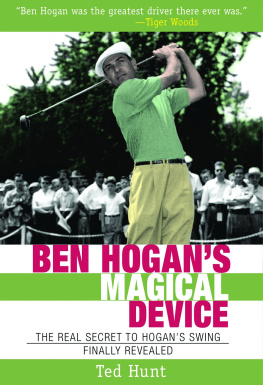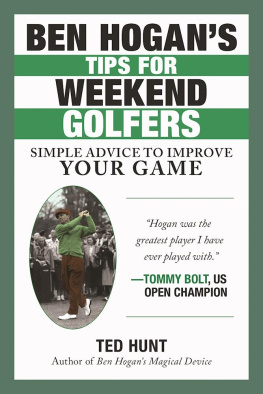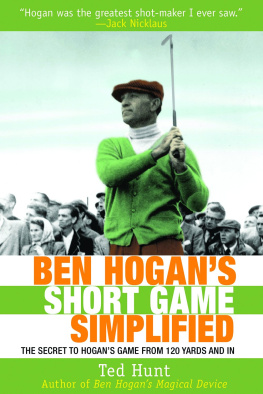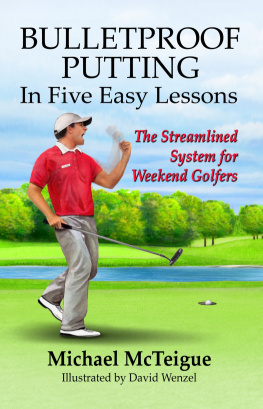Also by John Andrisani:
101 Supershots (with Chi-Chi Rodriguez)
A-Game Golf (with John Anselmo)
The Bobby Jones Way
Everything I Learned about People, I Learned from a Round of Golf
The Four Cornerstones of Winning Golf (with Butch Harmon)
The Golf Doctor (with Robin McMillan)
Golf Heaven
GOLF Magazines Complete Book of Golf Instruction (with George Peper, Jim Frank, and Lorin Anderson)
Golf Rules Plain and Simple (with Mark Russell)
Golf Your Way (with Phil Ritson)
Golfweeks 101 Winning Golf Tips
Grip It and Rip It! (with John Daly)
Hit It Hard! (with Mike Dunaway)
The Hogan Way
How to Perfect Your Golf Swing (with Rick Smith)
I Am the Walrus (with Craig Stadler)
The Killer Swing (with John Daly)
Learning Golf: The Lyle Way (with Sandy Lyle)
The Michelle Wie Way
Natural Golf (with Seve Ballesteros)
The Nicklaus Way
The Plane Truth for Golfers (with Jim Hardy)
The Plane Truth for Golfers Master Class (with Jim Hardy)
Play Golf the Tiger Woods Way
Play Like Sergio Garcia
Playing Lessons (with Butch Harmon)
The Power-Game Pocket Companion (with Jim McLean)
The Short Game Magic of Tiger Woods
SuperGolf (with Rick Grayson)
Think Like Tiger
The Tiger Woods Way
Tigers New Swing
Total Golf (with Phil Ritson)
Total Shotmaking (with Fred Couples)
The Wedge-Game Pocket Companion (with Jim McLean)
The X-Factor Swing (with Jim McLean)

The information in this book is meant to supplement, not replace, proper exercise training. All forms of exercise pose some inherent risks. The editors and publisher advise readers to take full responsibility for their safety and know their limits. Before practicing the exercises in this book, be sure that your equipment is well-maintained, and do not take risks beyond your level of experience, aptitude, training, and fitness. The exercise and dietary programs in this book are not intended as a substitute for any exercise routine or dietary regimen that may have been prescribed by your doctor. As with all exercise and dietary programs, you should get your doctors approval before beginning.
Mention of specific companies, organizations, or authorities in this book does not imply endorsement by the author or publisher, nor does mention of specific companies, organizations, or authorities imply that they endorse this book, its author, or the publisher.
Internet addresses and telephone numbers given in this book were accurate at the time it went to press.
2013 by John Andrisani
All rights reserved. No part of this publication may be reproduced or transmitted in any form or by any means, electronic or mechanical, including photocopying, recording, or any other information storage and retrieval system, without the written permission of the publisher.
Book design by Elizabeth Neal
Library of Congress Cataloging-in-Publication Data is on file with the publisher.
ISBN-13: 9781609614881 paperback
eISBN-13: 9781609614898

We inspire and enable people to improve their lives and the world around them.
rodalebooks.com
For Deborah Atkinson
Always number one in my book,
always there for me, unconditionally,
and for that I am grateful,
and will be, forever.
CONTENTS
.
.
.
.
CHAPTER 5:
.
.
FOREWORD
John Andrisani and I have been friends for 25 years and, like John, I have a deep passion for golf and an even deeper interest in golf instruction, as a former teaching professional affiliated with the Jim McLean Golf School and a longtime amateur golfer. I now play to a low handicap, having regained my amateur status, yet, just like middle- and high-handicap golfers, I can always use help, especially in the three most important departments of the game: driving, wedge play, and putting. So when John telephoned me to say he was working on a new book on putting, I was intrigued.
But when I learned the book would focus on Ben Hogan, I took particular interest. I was Mr. Hogans personal assistant in 1981 and 1982. By the time I worked for him, his career as a tour professional was over, yet he still spent a lot of time doing two things, almost daily, that we can all learn from.
Mr. Hogan experimented in practice, typically on the putting green at Shady Oaks Country Club, his favorite Texas spot, doing what he had done his entire career: testing out different putting grips, stances, ball positions, back-and-through paths to swing the putter alongtechnical nuances of all kindslooking for something new to add to an already solid system.
Mr. Hogan tweaked his putter in his at-home workshop in Fort Worth, Texas: doing such things as changing the grip to a round grip, paddle grip with flat top and round sides, paddle grip with flat top and flat sides, leather grip, thick chord grip, adding weight to the putters head, changing the lie and/or loft of the putter, all for the purpose of trying to determine what works best and what can work better than ever.
From observing Mr. Hogan putt, in practice and in play, I would like to add something to Johns analysis of the square-to-square stroke, something I know to be Mr. Hogans mainstay stroke action. Mr. Hogans secret was making sure that his eyes were over the target line, the same path the club is to travel along. I also learned this from chatting with Mr. Hogan and watching him employ the on-line putting stroke: You do not need to have an upright putter to employ this stroke. Mr. Hogan is using a flat-lie putter, a couple of degrees flatter than standard, on the cover of this book. Just look how square he keeps the putters face through impact. It just doesnt get any better than that! Another of Mr. Hogans secrets for employing square and solid contact with the golf ball has to do with a Double-Overlap grip he discovered, and which John is going to tell golfers like you about, for the very first time.
Whereas my main interest in any instructional putting book involves discovering new tips that will allow me to employ a more technically correct putting stroke more consistently, Hogan on the Green is of special interest to me, owing to my having worked for Mr. Hogan, in what seems a lifetime ago. After reading a late draft of Johns book, I felt I had gone back in time, when every day of the week I met Mr. Hogan in his office at 10 oclock sharp and, whenever possible, I would take a late lunch just so I could watch him practice hitting full shots. If the Texas weather was just a little too hot to hit drives and irons, Id watch Mr. Hogan practice putting, although a lot of the time he would hit putts when no one was around. And, without giving the book away, let me just tell you why.
As John explains, Mr. Hogan was working on perfecting a revolutionary putting system, and cared so much about getting it rightand right meant perfecteven after retiring from competition, that he tweaked it over and over so that golfers could benefit from the secrets he discovered.










